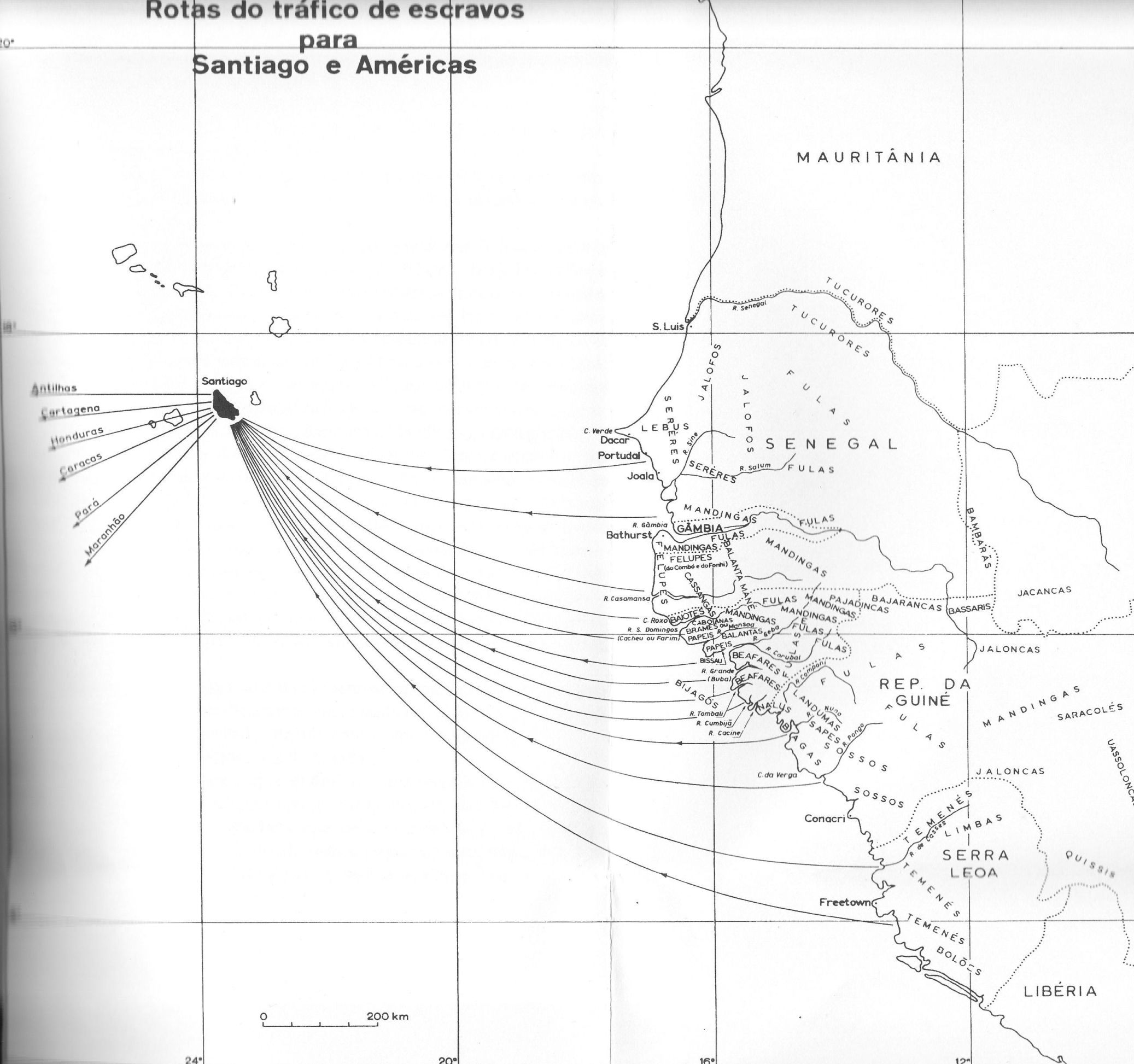Cape Verde & Upper Guinea
Nowadays when the average Cape Verdean is asked about his mainland African origins the first thing he will most likely mention is Guiné. Which by default would imply modernday Guiné Bissau. Not surprising given the long mutual history of these ex-Portuguese colonies. However a more correct interpretation would be Upper Guinea or as it was known in the 1500’s “Guiné de Cabo Verde”.
Actual control by the Portuguese was ever decreasing from the moment Northern Europeans (from France, England and the Netherlands) made their first appearance on the scene at the end of the 1500’s. Even though the Portuguese kept claiming the whole area as their exclusive domain (meaning seaborne trade, there were no actual territorial conquests besides Cape Verde). That’s why nowadays Guiné Bissau is only a small part of Upper Guinea especially after Casamance (southern Senegal) also got ceded to France in 1888.
Still there’s plenty of evidence that people from outside of Guiné Bissau & Casamance kept entering Cape Verde not only in the 1500’s/1600’s but also in the 1700’s and 1800’s. The trading and cultural connections of Cape Verde & Guiné Bissau with Luso Africans operating outside of Guiné Bissau/Casamance are probably the main reason behind this. Cape Verdean priests have been reported to still visit (irregularly) Luso-African settlements in Gambia and Sierra Leone in the 1700’s. Even more so Luso Africans outside of Guiné Bissau would be connected with Luso Africans in Cacheu and Bissau in Guiné Bissau which functioned as regional entrepots based on relay trading. Additionally continued English/French slave imports in the early 1700’s from Senegambia proper have been documented for Cape Verde.
Cape Verde-based traders and Luso African traders took over ancient regional trading networks which were already existing before the arrival of the Portuguese. Although ultimately slave trading was deemed to be most profitable in fact a very diverse trading system was being maintained. Africans insisting on barter trade and a very localized demand of specific goods ensured that trading patterns were very much regionally interdependent.
Besides mere continuation of already exisiting trading patterns it can be argued that Cape Verde-based traders and Luso African traders also expanded (volume of trading goods and areas being serviced) and enhanced/innovated (new products and markets) regional trade. Naturally they were motivated by selfinterest (just like their African trading partners). But leaving aside the socially disrupting slave trade possibly they actually also might have generated some positive effects for local economies. Especially the Colombian Exchange of crops (maize, manioc, etc.) might have been beneficial.
***
Guiné de Cabo Verde
This map is depicting the situation around 1580. However many of these regional trading networks within Upper Guinea (from Senegal to Sierra Leone) were maintained by Crioulo speaking Luso-Africans up till the late 1700’s. They were living in small communities scattered across the Upper Guinean coastal line. Their cultural and genetic bonds with Cape Verde were also being maintained in later centuries until complete assimilation and modern imperialism set in during the 1800’s. Many historians have studied these trading networks. Especially the work of George E Brooks is highly recommended!
(click to enlarge)
Source: Atlantic Islands: Madeira, the Azores, and the Cape Verdes in Seventeenth-Century Commerce and Navigation (T. Bentley Duncan, 1972).
***
Slave trade from Upper Guinea to Latin America by way of Cape Verde
This map is depicting the situation during the mid 1500’s when Cape Verde’s function as a main hub for Trans-Atlantic Slave Trade was having its peak. Cape Verde’s functioning as a major slave trade port is assumed by historians to have ended in the 1600’s. Cacheu in Guiné Bissau was deemed to be more convenient. The captives were overwhelmingly heading for the Hispanic Americas in this early timeperiod. Genetically speaking this is still detectable in the African DNA of many Latin Americans. I have termed this as a Upper Guinean Founding Effect. See these blogposts for more discussion:
- Shared Upper Guinean roots between Cape Verdeans and Latin Americans (Fonte Felipe, 2014)
- Upper Guinean Founding Effect for Hispanic Americans (Fonte Felipe, 2020)
- 23andme’s African breakdown put to the test: Afro Diaspora edition! (Fonte Felipe, 2021)
***
(click to enlarge)

***
Upper Guinea and Lower Guinea
This map is showing the location of historicallly documented ethnic groups and their so-called “casta” ethnonyms.

***
Modernday Upper Guinea
Senegambia
First map is not very detailed but clearly showing the main currentday ethnic groups found within Semegambia.
***
This map is much more detailed. Also showing the marginalized Banhun/Bainouk areas as well as the Tenda speaking communities (Bassari & Bedik)
***
This map is showing contrast between Atlantic and Mande speaking groups, essential for understanding the dynamics of Upper Guinean history.
***
This map is showing the corridor of Mandinga speakers, starting in Gambia, via Casamance into Guiné Bissau. The Kaabu empire united most of these areas in former times.
***
Guiné Bissau
All of the main ethnicities mentioned in historical sources are being shown. However some groups were heavily marginalized. Especially the Banhuns, Cassangas and Tenda. Also the Fula dominance being shown is pretty much recent following their conquest of the Kaabu state in 1867. The Fula had been present in Guiné Bissau already in the 15th century though.
Guiné Conakry
Again all ethnicities being mentioned in historical literature are being shown but some of them with much reduced territory. Especially the coastal Baga. The Susu were driven to the coast because of the expansion of the Fula in the 18th century. They would have been more interior in the 1500’s/1600’s. Also the Djallonke got displaced in the process.
Sierra Leone
The Mende presence is a result of the Mané (=Mande speaking) invasions of the 16th century. Otherwise the Temne, Limba and Sherbro pretty much correspond with the lump category of Sape peoples used in the 1500’s/1600’s. From these peoples the Temne had the most extensive trading relations with Cape Verdeans & Luso Africans.










